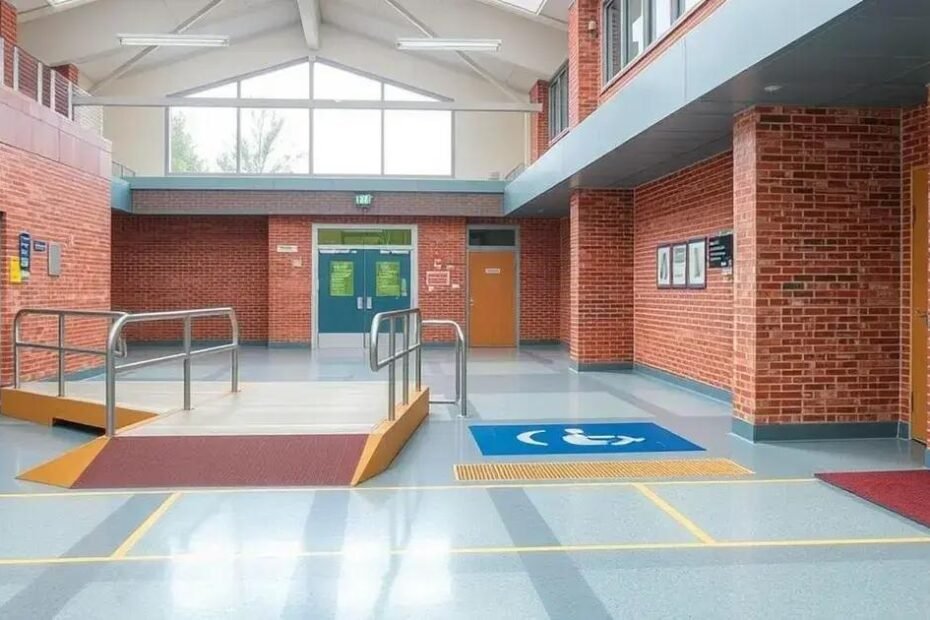Mandated audits on school accessibility are legal reviews that ensure educational institutions meet required standards, promoting inclusive environments for students with disabilities and enhancing overall educational outcomes.
Mandated audits on school accessibility are becoming increasingly important for educational institutions. These audits help ensure that schools are equipped to support all students, including those with disabilities. Have you considered how these changes might affect your school?
Understanding mandated audits on school accessibility
Understanding mandated audits on school accessibility is crucial for creating inclusive environments. These audits examine how well schools accommodate all students, especially those with disabilities. Schools need to ensure that they meet legal standards and provide a safe and supportive space for everyone.
What is a mandated audit?
A mandated audit is a systematic review required by law to assess compliance with accessibility standards. These audits look into various aspects, including building design, facilities, and services offered to students. Conducting these audits helps identify areas that may need improvement.
Key elements of the audit process
- Evaluation of physical accessibility features, such as ramps and elevators.
- Assessment of educational materials and resources for accessibility.
- Review of school policies concerning accommodations for students with disabilities.
Once an audit is conducted, schools receive a report outlining compliance and any necessary modifications. This process not only helps in meeting legal obligations but also fosters a culture of inclusivity.Accessibility audits are a proactive measure that supports students’ needs and promotes equality in education.
Through these evaluations, schools can pinpoint strengths and weaknesses in their accessibility initiatives. Additionally, by involving stakeholders like students and parents in the audit process, schools can obtain valuable insights into their effectiveness.
The importance of compliance
Compliance with accessibility standards is not just a legal requirement; it’s about ensuring every student can thrive. Non-compliance can lead to lawsuits and loss of funding. By staying compliant, schools demonstrate their commitment to inclusivity.
Furthermore, schools that actively address accessibility issues can enhance their reputation and attract more families to their programs. This approach shows that the institution values diversity and is committed to providing equal opportunities for all.
Steps to prepare for an accessibility audit
- Ensure all staff are trained on accessibility standards.
- Conduct a self-assessment of current practices.
- Involve students and parents in the preparation process.
Staying informed about updates in accessibility laws ensures that schools are not only compliant but also proactive in addressing potential challenges. As a result, these audits play a significant role in establishing a more equitable educational landscape.
Legal requirements for school accessibility audits
Legal requirements for school accessibility audits are essential in ensuring that all educational institutions provide a safe and accommodating environment for students with disabilities. These laws exist to protect the rights of individuals and promote equal access to education.
Understanding the laws
Several key laws govern accessibility in schools, primarily the Americans with Disabilities Act (ADA) and Section 504 of the Rehabilitation Act. These laws mandate that public entities, including schools, must comply with accessibility standards.
Key legal provisions
- Schools must eliminate barriers that prevent students with disabilities from fully participating in educational activities.
- Facilities must be physically accessible, including classrooms, restrooms, and common areas.
- Accommodations must be provided for events and activities, ensuring all students have equal opportunities.
Regular audits help schools assess their compliance with these legal requirements. By identifying failures to meet standards, schools can take necessary actions to address deficiencies. Understanding the specific provisions in these laws can help educational institutions effectively meet their obligations.
Moreover, it is essential for schools to stay informed about updates or changes to accessibility laws. This ensures they are making necessary adjustments and improvements. These proactive measures not only help in compliance but also foster an atmosphere of inclusivity and respect.
The role of state laws
In addition to federal legislation, many states have their own laws that further protect students with disabilities. Local regulations may impose stricter accessibility standards, which schools must also adhere to. Understanding these requirements is crucial for maintaining compliance and avoiding potential legal issues.
Engaging with local advocacy groups can also provide valuable insight into best practices for enhancing accessibility. These partnerships can help schools develop more effective audits and ensure that they address all aspects of accessibility.
Steps to prepare for an accessibility audit

Preparing for an accessibility audit is an important step for schools aiming to enhance compliance with mandated audits on school accessibility. It involves several actionable steps that can help ensure a thorough and effective evaluation.
Conduct a self-assessment
The first step is to conduct a self-assessment of your school’s current accessibility features. This involves evaluating physical spaces, instructional materials, and programs. Look for barriers that might prevent students with disabilities from fully participating in the educational experience.
Involve the school community
Engaging the school community is crucial. Involve students, parents, and staff in the preparation process. Gathering feedback can provide valuable insights into accessibility challenges that may not be immediately visible.
- Organize focus groups with students and families to discuss their experiences.
- Establish a committee that includes diverse perspectives, particularly from those with disabilities.
- Gather input from teachers regarding teaching materials and resources.
Next, ensure that all staff are trained on accessibility standards and the significance of compliance. This training can empower them to identify issues and work collaboratively on solutions.
Review supporting documentation
Before the audit, review all relevant documentation and resources. This includes policies, previous audit reports, and any complaints related to accessibility. Staying organized will help streamline the audit process.
Establishing a clear timeline for the audit preparation is essential. Break down tasks into manageable steps, ensuring that there is sufficient time to complete each phase. This will help reduce stress and ensure thoroughness in your preparations. Ensuring that all areas of accessibility are addressed—be it architectural, pedagogical, or administrative—is vital for achieving compliance.
Conduct a mock audit
Consider conducting a mock audit to understand potential shortcomings. This exercise can involve staff members pretending to be auditors, which may reveal unforeseen issues or areas requiring improvement.
By following these actionable steps, schools can prepare comprehensively for accessibility audits. Preparation not only ensures compliance but fosters an environment that supports all learners.
Common challenges faced during audits
Common challenges faced during accessibility audits can significantly impact how effectively schools meet the requirements of mandated audits on school accessibility. Understanding these challenges is crucial for improving the audit process and ensuring compliance.
Identifying physical barriers
One major challenge is identifying all physical barriers that limit access. Many schools have outdated facilities, which can include narrow doorways, insufficient ramps, and inaccessible restrooms. These barriers may not be immediately apparent, requiring thorough inspections.
Lack of awareness and training
Often, there is a lack of awareness among staff regarding accessibility standards. Many school employees may not know what to look for during the audit process. This lack of training can lead to incomplete assessments. Ensuring staff have proper training is vital for a successful audit.
- Providing ongoing professional development on accessibility.
- Encouraging staff to receive training from experts in the field.
- Fostering a culture of inclusivity within the school community.
Another challenge is the resistance to change from staff and stakeholders. Many may view audits as an inconvenience rather than an opportunity for improvement. Building support and understanding within the community can help overcome this barrier.
Resource constraints
Resource constraints, such as limited funding and personnel, may hinder the audit process. Many schools struggle to allocate sufficient resources for maintenance and upgrades. This situation can complicate efforts to rectify identified issues after an audit.
Additionally, schools must work within tight timelines to complete audits and implement changes. This pressure can make it difficult to thoroughly address accessibility concerns.Engaging local community support can provide additional resources for schools facing these constraints, enabling them to improve accessibility effectively.
Documentation and compliance difficulties
Finally, navigating the documentation required for compliance can be overwhelming. Schools must ensure they have all necessary records to demonstrate compliance with accessibility laws. Inconsistencies or missing documents can complicate the audit process.
The combination of these challenges highlights the need for proactive measures to prepare for audits. By addressing potential obstacles ahead of time, schools can create a more inclusive environment for all students.
Benefits of ensuring school accessibility compliance
Ensuring school accessibility compliance offers numerous benefits that go beyond just meeting legal requirements. Schools that prioritize accessibility create welcoming environments for all students, particularly those with disabilities.
Improved educational outcomes
One significant benefit of compliance is improved educational outcomes for students with disabilities. When schools provide accessible facilities and resources, students can fully participate in academic activities. This inclusion helps foster a positive learning experience, ultimately leading to better academic performance.
Enhanced school reputation
Compliance with accessibility standards also enhances a school’s reputation within the community. Families are more likely to choose schools that show a commitment to inclusivity. A positive reputation attracts diverse students and promotes a culture of acceptance.
- Access to specialized programs and services increases.
- Greater parental involvement and support.
- Improved relationships with community stakeholders.
Moreover, schools that embrace accessibility demonstrate their commitment to social responsibility. This commitment not only benefits students but also reflects positively on the school’s values and mission.
Attracting funding and resources
Another advantage of accessibility compliance is the potential for increased funding and resources. Many grant programs prioritize schools that are accessible and inclusive. By meeting these standards, schools can attract additional financial support to enhance their programs and facilities.
Furthermore, maintaining compliance reduces legal risks associated with accessibility violations. Schools that proactively address accessibility concerns can avoid costly lawsuits and the negative publicity that comes with them. Ensuring everyone can access educational opportunities is not just a legal obligation but a moral imperative that benefits the entire school community.
FAQ – Frequently Asked Questions about School Accessibility Compliance
What are mandated audits on school accessibility?
Mandated audits are reviews required by law to ensure schools meet accessibility standards for students with disabilities, promoting inclusivity.
Why is school accessibility important?
School accessibility is crucial to provide equal educational opportunities for all students, fostering a learning environment where everyone can succeed.
What challenges do schools face during accessibility audits?
Common challenges include identifying physical barriers, lack of staff awareness about accessibility standards, and limited resources for necessary changes.
How can schools benefit from ensuring accessibility compliance?
Benefits include improved educational outcomes for students, enhanced school reputation, increased funding opportunities, and reduced legal risks.

